February has arrived, and believe it or not, it is time to start prepping for the spring garden season in San Antonio by planting and pruning specific plants. We all know that in this area, the weather can have us shoving our feet in wool socks and boots one day and tossing them aside in favor of flip flops the next. We’ve all seen the memes, right? While we try to follow a calendar for our seasonal gardening, we really rely on the weather and temperatures more than anything to be successful. This means, we still need to be ready for planting and pruning at “normal” times, but we must be prepared to wait or protect our plants in case of an errant late freeze.
Today, I’m going to try to give you some timely planting and pruning gardening tips for February. Keep in mind that these are general timing tips and that the weather in February and March can make a big difference. Make sure to follow this up by reading, Jump Start Spring Part 2: Lawn and Soil Prep.
February Early Spring Planting Do’s
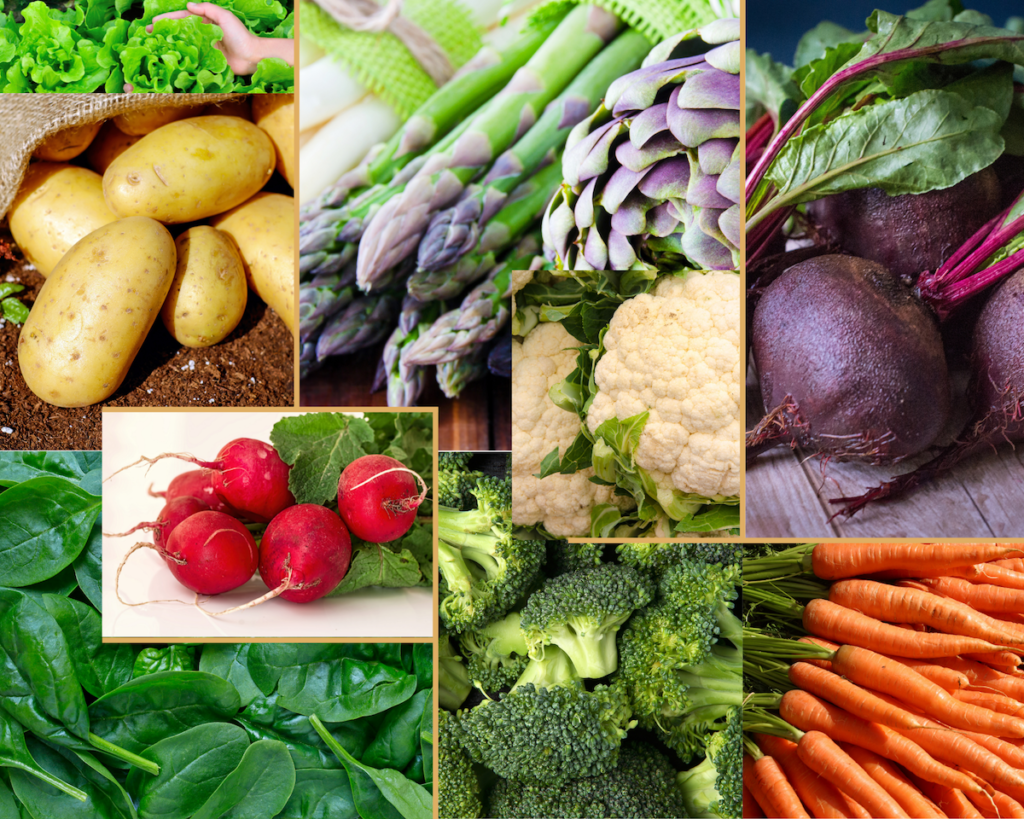
*Always remember that ALL new plantings are tender and MUST be protected in the event of a freeze.
Veggie Planting:
- If you do it soon: broccoli, cauliflower, kale, cabbage and other cole crops. What we have is most likely our last selections, so get them soon if you want them. Cole crops tend to bolt (flower) once the warm weather hits, causing the veggies to taste bitter by the time they mature.
- Fresh veggie plantings of potatoes, artichokes, asparagus, green onions (not for big bulbs), lettuce, spinach, asian greens, and direct seedings of root veggies: carrots, radish, turnip, kohlrabi, beets, etc…
- Ok hear me out….tomatoes will be in the nursery by about mid month (maybe sooner. This is the time to BUY them, but NOT plant yet. Now is when you will get the selection you desire, but the small transplants should be bumped up to larger containers to continue to develop roots but still be protected from the cold until about March 15th (weather dependent).
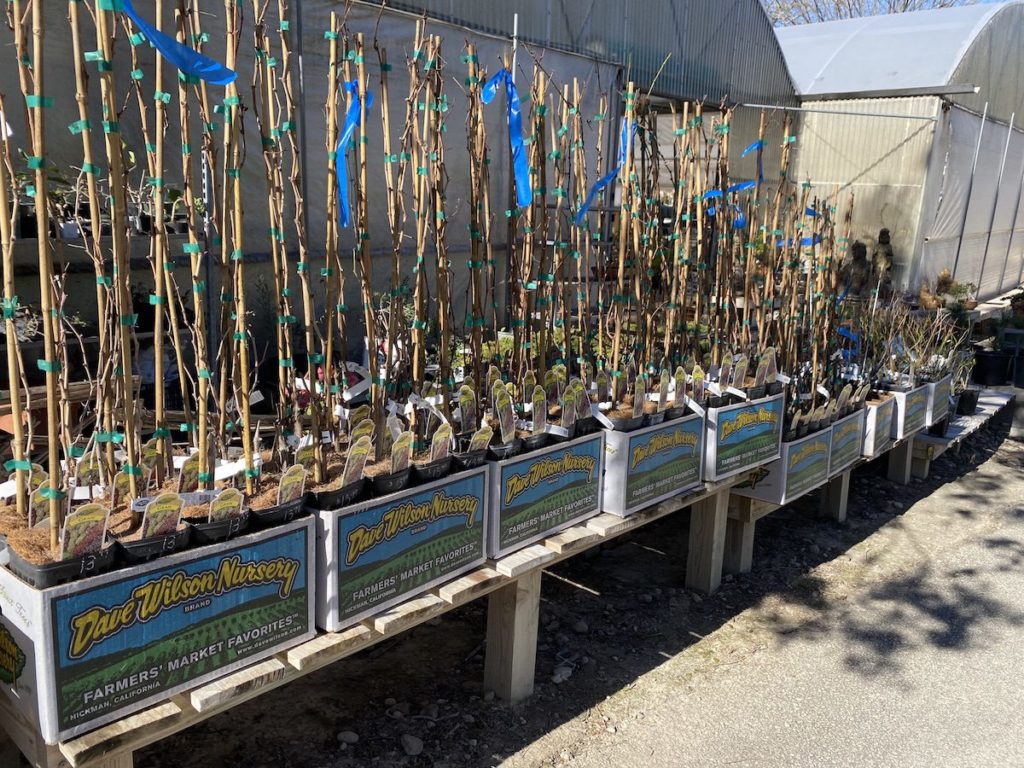
Shade Trees, Shrubs, Fruit Trees, Nut Trees and Berry Planting:
Trees and shrubs are those type of plants that take longer to get their roots established. While warm weather gets us excited to be outdoors planting trees and shrubs, it’s better to plant earlier so they have as much time possible to develop their roots to be able to withstand our summers. Fall is best for planting, late winter/early spring is your next shot.
If you want to include hardy fruit trees, nuts, berries, grapes, etc… Not only is February a good time to plant fruit, it is also prime time for selecting a great variety as both of our locations have welcomed in huge shipments. Look for apples, peaches, plums, figs, pomegranate, persimmon, pecans, berries, grapes, and specialty fruits from David Wilson Nursery like: kiwi, specialty raspberries and grapes, goji berries, hops, etc… These also need as much time possible to get their roots established before the heat rolls in.
Extra tip: Even self-pollinating fruit varieties tend to produce more when provided another variety of fruit tree/bush/vine to cross pollinate with
Planting Indoor Seed Starts of Warm Weather Annuals
Seeds of zinnia, marigolds, basil, gomphrena, gaillardia, etc…like the warmth and won’t do well planted in the garden right now. If you want to grow your own from seed, start these indoors now to have strong transplants for the garden later when the sun starts doing its thing.
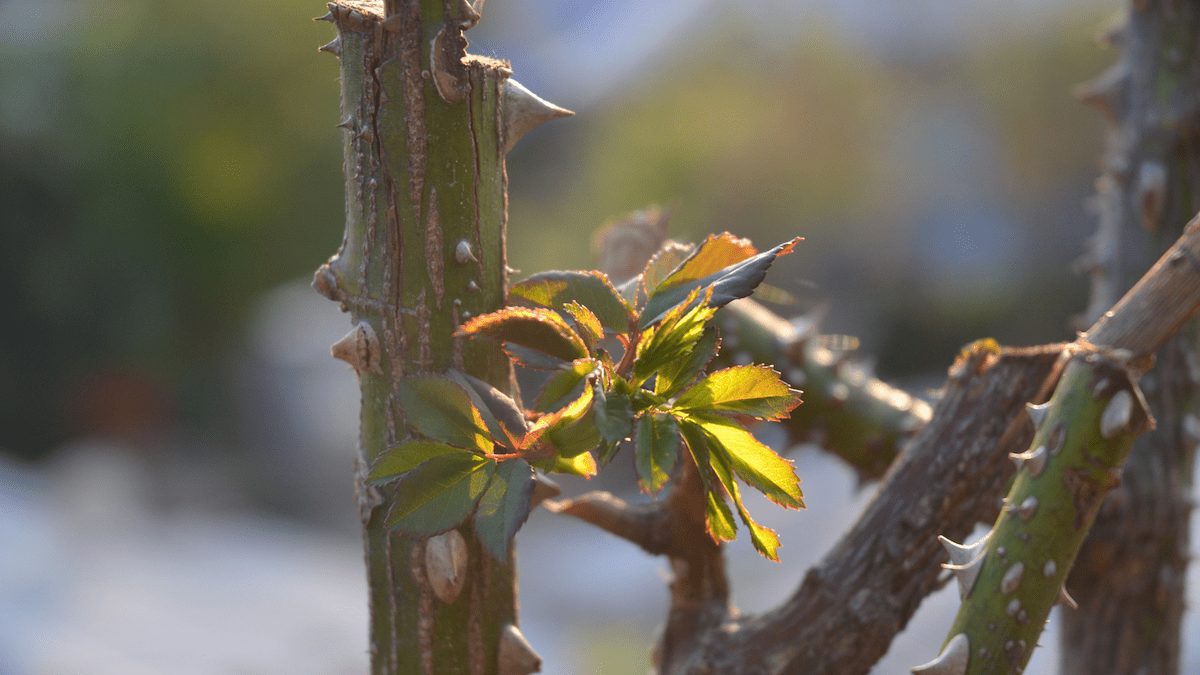
Early Spring Pruning Do’s and Don’ts
Time for Pruning Roses:
February is prime time to do your major spring rose pruning. We use Valentine’s Day as a good marker for when to start and the first week of March to have completed this gardening task. In general, you are removing old, broken and damaged canes, with the goal of ending up with 6-8 healthy canes cut down to a height of about 24”. (You may get fewer blooms but they will be bigger, pruning the plant a little taller will give you more blooms but they will be smaller.)
Exceptions to rose pruning in February are: groundcover roses (they don’t usually need to be cut down too severely, just to maintain shape), old garden roses (wait until after spring bloom to prune), and climbing roses have a more specific way to prune and train. Sterilized and sharp pruners are a must for this task. Need your pruners sharpened? Take advantage of dropping your tools off at the “Hello Sharpness”, box at both of our locations for professional sharpening.
Pruning Summer Flowering Trees and Fruit Trees
I am attaching a link to this informative article from TAMU about pruning trees, with a chart showing some examples of which ones to prune now and which ones to prune later. It also gives you some great tips for how to prune. But here is my warning. I better not see any of your crape myrtles hacked down to nubs! I mean it! Enough of that!
February is prime time to prune fruit trees in San Antonio. This will encourage larger fruit at production. Pruning should be done before buds swell, so don’t delay. Those fruit trees put out their gorgeous buds and blooms pretty early here in San Antonio. Extra info here.
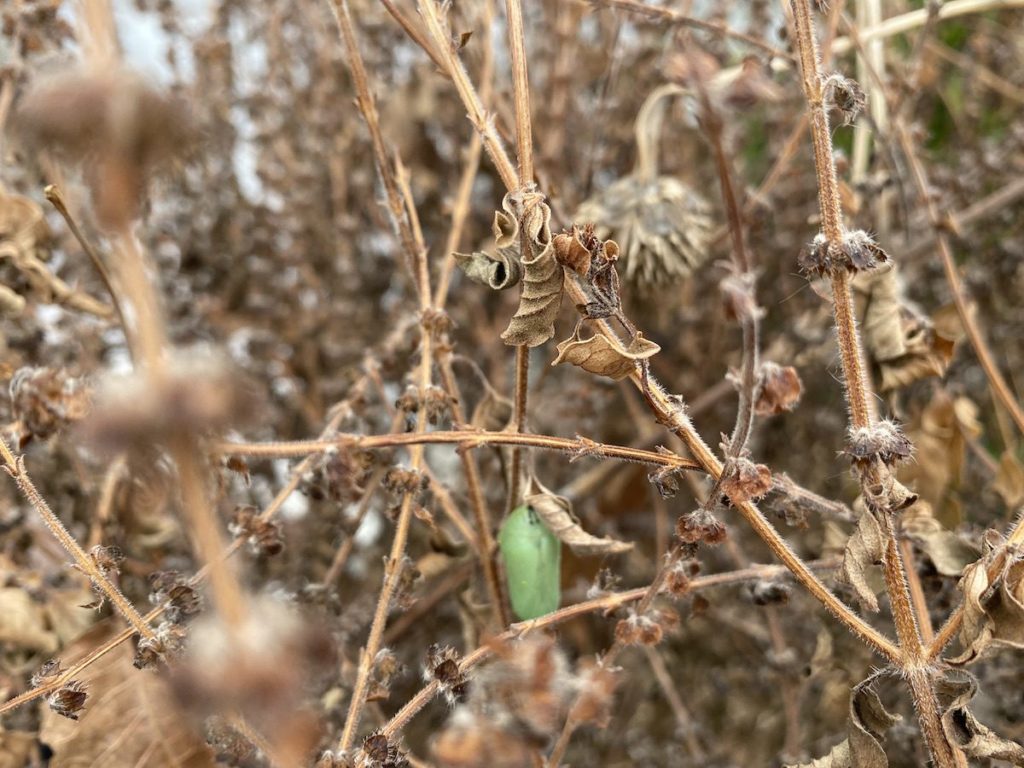
Prune or Don’t Prune Perennials and Ornamental Grasses…What?
Okay, this one is tricky. It honestly kind of comes down to a preference. There is a lot of advice (from reliable sources like TAMU Agrilife Extension Services, etc…) to go ahead and trim perennials down to about 4” and ornamental grasses to about 10”. This is valid advice, and it can be done. If you do prune down your perennials and grasses now, be sure to add a 2″-3″ layer of mulch around the base of your plants to help protect their roots.
Now, the other method of addressing your freeze burned plants is to do nothing yet. THIS is what I do. I wait until the temperatures are consistently above 50°F, and the picture above shows why (see the chrysalis at the bottom center of pic?). Many butterflies, bees, and other pollinators overwintering in the winter damaged leaves and hollowed out stems. I leave the tops of my plants alone, mostly for shelter and protection of our local wildlife, but I also believe the browned, ragged rubble also serves as more protection for my plants in the event of additional freezes. This week proves my point.
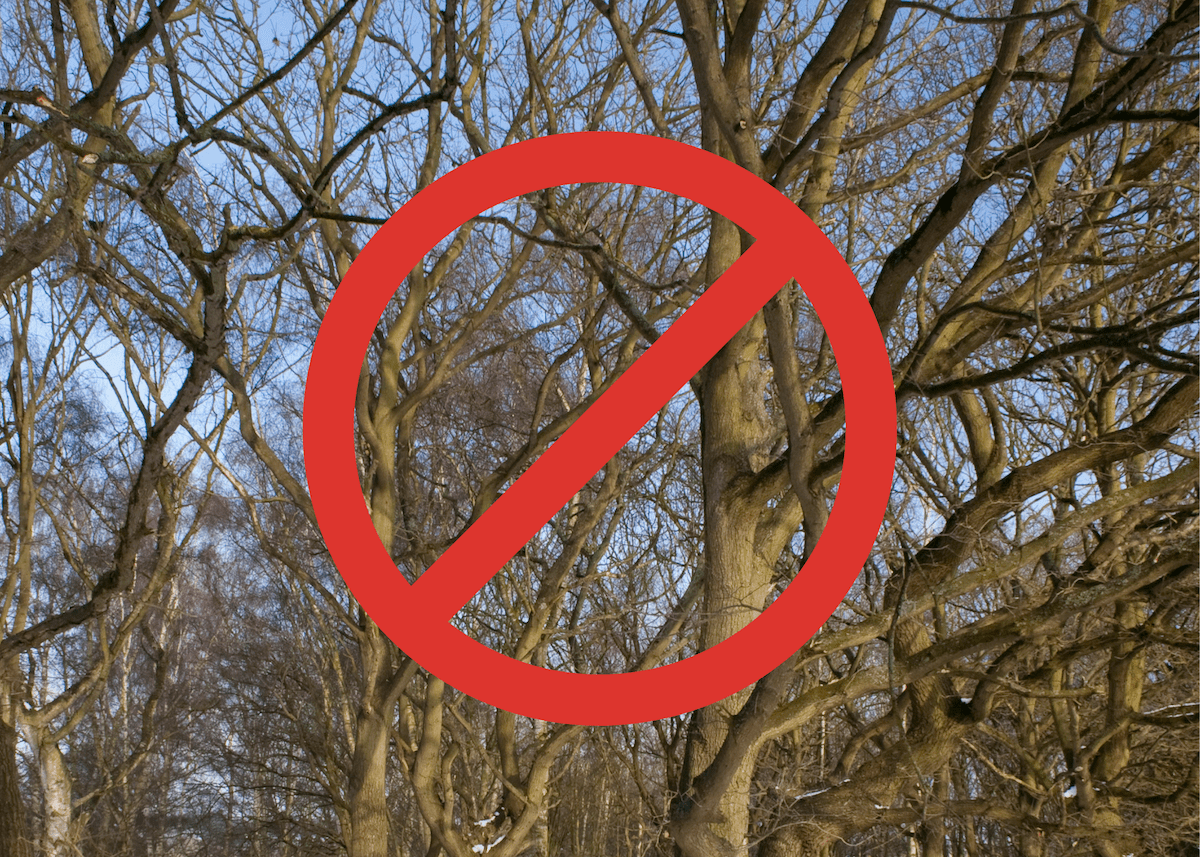
No Pruning for Spring Blooming Shrubs, Oak Trees, and Tropical Plants
If you prune these now, guess what? No blooms in springtime! For a list of some common spring blooming shrubs to avoid pruning, see this link. You can prune these right after their flower flush. This allows for vigorous summer growth and will encourage lots of spring buds next year.
From February to June 30th, you should refrain from pruning oaks to help prevent the spread of oak wilt throughout Texas. If you have to prune a broken branch from winter damage, do so selectively and be sure to paint the wound completely with pruning paint.
These are the most cold sensitive plants out there. Pruning them now would definitely put them at risk for severe damage or death by a late freeze. You do have them in a warm and protected area for winter right?
I hope these little tidbits will help give you a jump start on spring planting and pruning. Here’s to a successful spring season. Until then, stay safe and warm!
~The Happy Gardener, Lisa Mulroy


Trouble with crate Myrtle’s small tree never blossomed do I prune what can I do to get some color and when do you offer training for this type of tree bush etc
Hi Jerry,
Do your crape myrtles get plenty of sun? Have you tried fertilizing them? (Nelson has a good fertilizer for crape myrtles.) What about your watering schedule this summer? The drought was pretty tough on some of our favorite bloomers so that could have been a culprit.
Pruning can start mid February. Remember that you should never top crape myrtles! You can remove anything small than the diameter of a pencil, the suckers at the bottom, any crossing or rubbing limbs and any limbs you find growing towards the center of the tree/shrub (to open up air circulation).
We hope to put out a video on youtube soon showing the proper way to prune a crape myrtle.
Can I start pruning my crape myrtles?
Hi Myrtha,
Yes, around mid February you can start to prune your crape myrtles. Remember that you should never top crape myrtles! You can remove anything small than the diameter of a pencil, the suckers at the bottom, any crossing or rubbing limbs and any limbs you find growing towards the center of the tree/shrub (to open up air circulation).
Can I start pruning my boganvillas
Hi Myrtha,
I would suggest waiting until March/mid March. Not sure I trust the groundhogs’ prediction of an early spring just yet. The dead areas from a frost are still a layer of protection against another frost for now.
Is now a good time to plant blue bonnets? Bulbs? Wildflower seeds?
Hi Mike,
Bluebonnet transplants can be planted (if you hurry), but not the bluebonnet seeds. The seeds need to be sown over late fall (Nov.).
In general, wildflower seeds also get planted over that time period. However, we are carrying a starburst wildflower mix right now that you can plant in spring for summer wildflower blooms. While it may contain some bluebonnet seeds and other spring wilfdflowers, those won’t come up until next spring because they need cold stratification over winter to germinate. So, if you want flowers like coneflower, and coreopsis, and other summer blooms.. the spring wildflower mix may be an option for you now.
Spring bulbs also need a “chilling period” over winter, so spring bulbs should have been bought in September/October and chilled
for 8-12 weeks, and then planted. We do currently have transplants of some of these spring bulbs available.
Early spring is the time for planting perennials, annuals, herbs, spring veggies, and trees and shrubs (the early you get them in, the better they will be able to survive their first battle with our hot summer.) Hope this helps.
I have bedrock a few inches under the soil and can dig deep enough for plants. Are there any that don’t need a deep hole? Suggestions?
Hi Scott,
It is a struggle with our limestone rocky soil in San Antonio, Texas for sure. We generally suggest using raised beds if you can’t dig down. This way plants have enough room for their roots to grow, and you don’t run into issues with soil drainage that you might if trying to plant ontop of rocks. Without knowing what your conditions are in your landscape, (sun/shade, soil type, etc…) and what type of plants you are interested in planting, it would be difficult to just randomly give you a list of plants.